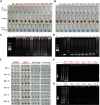Internal heating method of loop-mediated isothermal amplification for detection of HPV-6 DNA
- PMID: 35507110
- PMCID: PMC9065241
- DOI: 10.1007/s00604-022-05283-9
Internal heating method of loop-mediated isothermal amplification for detection of HPV-6 DNA
Abstract
Loop-mediated isothermal amplification (LAMP) is a promising diagnostic tool for genetic amplification, which is known for its rapid process, simple operation, high amplification efficiency, and excellent sensitivity. However, most of the existing heating methods are external for completion of molecular amplification with possibility of contamination of specimens. The present research provided an internal heating method for LAMP using magnetic nanoparticles (MNPs), which is called nano-LAMP. Near-infrared light with an excitation wavelength of 808 nm was employed as the heating source; hydroxy naphthol blue (HNB) was used as an indicator to conduct methodological research. We demonstrate that the best temperature was controlled at a working power of 2 W and 4.8 µg/µL concentration of nanoparticles. The lowest limit for the detection of HPV by the nano-LAMP method is 102 copies/mL, which was confirmed by a gel electrophoresis assay. In the feasibility investigation of validated clinical samples, all 10 positive HPV-6 specimens amplified by nano-LAMP were consistent with conventional LAMP methods. Therefore, the nano-LAMP detection method using internal heating of MNPs may bring a new vision to the exploration of thermostatic detection in the future.
Keywords: Genetic amplification; Human papillomavirus; Loop-mediated isothermal amplification; Magnetic nanoparticles; Nano-LAMP.
© 2022. The Author(s), under exclusive licence to Springer-Verlag GmbH Austria, part of Springer Nature.
Conflict of interest statement
The authors declare no competing interests.
Figures






Similar articles
-
A Loop-Mediated Isothermal Amplification Assay Utilizing Hydroxy Naphthol Blue (LAMP-HNB) for the Detection of Treponema pallidum Subspp. pallidum.Pathogens. 2024 Oct 31;13(11):949. doi: 10.3390/pathogens13110949. Pathogens. 2024. PMID: 39599503 Free PMC article.
-
[Colorimetric detection of HPV6 and HPV16 by loop mediated isothermal amplification].Bing Du Xue Bao. 2011 Jan;27(1):64-70. Bing Du Xue Bao. 2011. PMID: 21462508 Chinese.
-
Rapid diagnosis of seven high-risk human papillomavirus subtypes by a novel loop-mediated isothermal amplification method.Mol Cell Probes. 2022 Feb;61:101787. doi: 10.1016/j.mcp.2021.101787. Epub 2021 Dec 4. Mol Cell Probes. 2022. PMID: 34875349
-
[Research progress on analysis of human papillomavirus by microchip capillary electrophoresis].Se Pu. 2020 Oct 8;38(10):1179-1188. doi: 10.3724/SP.J.1123.2020.05016. Se Pu. 2020. PMID: 34213114 Review. Chinese.
-
Diverse methods of reducing and confirming false-positive results of loop-mediated isothermal amplification assays: A review.Anal Chim Acta. 2023 Nov 1;1280:341693. doi: 10.1016/j.aca.2023.341693. Epub 2023 Aug 7. Anal Chim Acta. 2023. PMID: 37858542 Review.
Cited by
-
Diagnostic techniques for critical respiratory infections: Update on current methods.Heliyon. 2023 Aug 5;9(8):e18957. doi: 10.1016/j.heliyon.2023.e18957. eCollection 2023 Aug. Heliyon. 2023. PMID: 37600408 Free PMC article. Review.
-
Advancements in nanobiosensor technologies for in-vitro diagnostics to point of care testing.Heliyon. 2024 Nov 9;10(22):e40306. doi: 10.1016/j.heliyon.2024.e40306. eCollection 2024 Nov 30. Heliyon. 2024. PMID: 39624329 Free PMC article. Review.
-
Isothermal Nucleic Acid Amplification for Point-of-Care Primary Cervical Cancer Screening.Viruses. 2024 Nov 28;16(12):1852. doi: 10.3390/v16121852. Viruses. 2024. PMID: 39772162 Free PMC article. Review.
-
Isothermal Technologies for HPV Detection: Current Trends and Future Perspectives.Pathogens. 2024 Aug 2;13(8):653. doi: 10.3390/pathogens13080653. Pathogens. 2024. PMID: 39204253 Free PMC article. Review.
-
The nucleic acid reactions on the nanomaterials surface for biomedicine.J Nanobiotechnology. 2025 Apr 23;23(1):308. doi: 10.1186/s12951-025-03374-2. J Nanobiotechnology. 2025. PMID: 40269855 Free PMC article. Review.
References
-
- Dobec M, Bannwart F, Kaeppeli F, Cassinottiet P. Automation of the linear array HPV genotyping test and its application for routine typing of human papillomaviruses in cervical specimens of women without cytological abnormalities in Switzerland. J Clin Virol. 2009;45(1):23–27. doi: 10.1016/j.jcv.2009.03.005. - DOI - PubMed
-
- Maniar KP, Ronnett BM, Vang R, Yemelyanova A. Coexisting high-grade vulvar intraepithelial neoplasia (VIN) and condyloma acuminatum: independent lesions due to different HPV types occurring in immunocompromised patients. Am J Surg Pathol. 2013;37(1):53–60. doi: 10.1097/PAS.0b013e318263cda6. - DOI - PMC - PubMed
Publication types
MeSH terms
Substances
Supplementary concepts
Grants and funding
LinkOut - more resources
Full Text Sources
